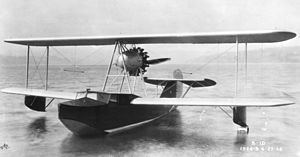Top speed 153 km/h Length 9.37 m | Wingspan 12 m First flight April 1928 | |
 | ||
The Boeing Model 6D (originally designated the Boeing B-1D) was an American pusher biplane flying-boat built by Boeing between 1928 and 1929.
Contents
Development and design
The Model 6D continued the designation series of the 1919 Boeing Model 6 but the only similarity was that they are both biplane pusher flying-boats. The 6D was designed in 1928 and 2 aircraft were built between May 1928 and April 1929. The 6Ds rectangular hull was constructed of wood with wood longerons, covered in spruce veneer. The wings were taken from the Model 40 and shortened. The pusher engine and wood propeller was mounted on the lower side of the upper wing.
Specifications
Data from Bowers, 1966. pg. 136.
General characteristics
Performance
References
Boeing Model 6D Wikipedia(Text) CC BY-SA
